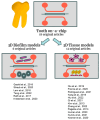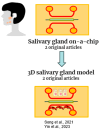A Systematic Review on Organ-on-a-Chip in PDMS or Hydrogel in Dentistry: An Update of the Literature
- PMID: 38391432
- PMCID: PMC10887950
- DOI: 10.3390/gels10020102
A Systematic Review on Organ-on-a-Chip in PDMS or Hydrogel in Dentistry: An Update of the Literature
Abstract
Organs-on-a-chip (OoCs) are microfluidic devices constituted by PDMS or hydrogel in which different layers of cells are separated by a semipermeable membrane. This technology can set many parameters, like fluid shear stress, chemical concentration gradient, tissue-organ interface, and cell interaction. The use of these devices in medical research permits the investigation of cell patterning, tissue-material interface, and organ-organ interaction, mimicking the complex structures and microenvironment of human and animal bodies. This technology allows us to reconstitute in vitro complex conditions that recapitulate in vivo environments. One of the main advantages of these systems is that they represent a very realistic model that, in many cases, can replace animal experimentation, eliminating costs and related ethical issues. Organ-on-a-chip can also contain bacteria or cancer cells. This technology could be beneficial in dentistry for testing novel antibacterial substances and biomaterials, performing studies on inflammatory disease, or planning preclinical studies. A significant number of publications and reviews have been published on this topic. Still, to our knowledge, they mainly focus on the materials used for fabrication and the different patterns of the chip applied to the experimentations. This review presents the most recent applications of organ-on-a-chip models in dentistry, starting from the reconstituted dental tissues to their clinical applications and future perspectives.
Keywords: microfluidic devices; oral cancer-on-a-chip; oral mucosa-on-a-chip; organ-on-a-chip; salivary glands-on-a-chip.
Conflict of interest statement
The authors declare no conflict of interest.
Figures








References
-
- Ehlers H., Nicolas A., Schavemaker F., Heijmans J.P.M., Bulst M., Trietsch S.J., van den Broek L.J. Vascular Inflammation on a Chip: A Scalable Platform for Trans-Endothelial Electrical Resistance and Immune Cell Migration. Front. Immunol. 2023;14:1118624. doi: 10.3389/fimmu.2023.1118624. - DOI - PMC - PubMed
-
- Si L., Bai H., Rodas M., Cao W., Oh C.Y., Jiang A., Moller R., Hoagland D., Oishi K., Horiuchi S., et al. A Human-Airway-on-a-Chip for the Rapid Identification of Candidate Antiviral Therapeutics and Prophylactics. Nat. Biomed. Eng. 2021;5:815–829. doi: 10.1038/s41551-021-00718-9. - DOI - PMC - PubMed
Publication types
LinkOut - more resources
Full Text Sources

